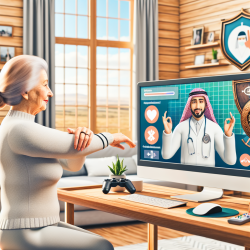As a speech-language pathologist dedicated to data-driven decisions and improving outcomes for children, it's crucial to stay informed about advancements in related fields. One such advancement is the effectiveness of telerehabilitation, as highlighted in the research titled "Effectiveness of Telerehabilitation for Correcting Posture in Elderly with Thoracic Kyphosis in Urban Thailand." This study presents valuable insights that can help practitioners enhance their skills and consider the potential of telerehabilitation for their patients.
Thoracic kyphosis (TK) is an abnormal curvature of the thoracic spine, often seen in the elderly. It can lead to significant issues such as forward head posture, back muscle weakness, and increased risk of falls. Traditional physical therapy has been effective in managing these symptoms, but telerehabilitation offers a promising alternative, especially for those unable to travel to a clinic.
Key Findings from the Study
- Both telerehabilitation and conventional physical therapy significantly improved thoracic angle, forward head posture, and back muscle strength in elderly patients.
- Cost-effectiveness analysis revealed that telerehabilitation was more economical, with an average cost of $420.15 compared to $555.15 for conventional therapy.
- Telerehabilitation showed no difference in efficacy compared to in-person treatment, making it a viable alternative for those with travel constraints.
Implications for Practitioners
Practitioners can leverage these findings to improve their services in several ways:
- Expand Service Reach: Telerehabilitation can extend services to patients who cannot visit the clinic, ensuring continuity of care.
- Cost-Effective Solutions: Implementing telerehabilitation can reduce costs for both the provider and the patient, making therapy more accessible.
- Enhance Patient Compliance: Real-time communication and immediate feedback can improve patient adherence to therapy programs.
Encouraging Further Research
While this study provides robust evidence supporting telerehabilitation, further research is essential to explore its long-term effects and applicability across different demographics and conditions. Practitioners are encouraged to contribute to this growing body of knowledge by conducting their own studies and sharing their findings.
To read the original research paper, please follow this link: Effectiveness of Telerehabilitation for Correcting Posture in Elderly with Thoracic Kyphosis in Urban Thailand.










